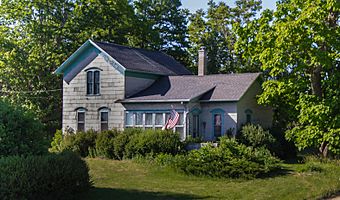Rock S. Edwards Farmstead facts for kids
Quick facts for kids |
|
|
Rock S. Edwards Farmstead
|
|
 |
|
| Location | 3503 Rock Edwards Rd., Sodus Township, Michigan |
|---|---|
| Area | 6 acres (2.4 ha) |
| NRHP reference No. | 95000868 |
| Added to NRHP | July 21, 1995 |
The Rock S. Edwards Farmstead is a special group of old farm buildings. You can find it at 3503 Edwards Road (now Sodus Parkway) in Sodus Township, Michigan. This farmstead is important because it shows us what farming life was like long ago. Because of its history, it was added to the National Register of Historic Places in 1995.
Contents
Farm History: A Look Back
Who Was Rock Edwards?
Rock Savage Edwards was born in 1829 in Shropshire, England. When he was 28, he moved to the United States. He worked hard on farms in Ohio and Michigan. His goal was to save enough money to buy his own land.
Starting the Farm
In 1860, Rock Edwards bought this farm for $420. That was a lot of money back then! He probably grew grains to sell in nearby Benton Harbor, Michigan. Soon after, he started planting fruit trees.
Serving His Country
In 1862, Rock Edwards joined the army to fight in the American Civil War. He was hurt in a big battle called the Battle of Antietam. People thought he had died, but he survived! He went home for a short time. Then, he bravely rejoined the fight. He was discharged from the army in 1865.
Building a Life
After the war, Rock Edwards married Miss Lydia E. Fox. They returned to his farm. He quickly started growing many crops. He earned enough money from farming to build a large house and a big barn.
By the early 1870s, the farm was very busy. It had fruit orchards that produced a lot of fruit. They also had dairy cows, sheep, and chickens. Fields of wheat, oats, and rye grew on the land.
Passing It On
Rock Edwards farmed the property until 1904. Then, he gave the farm to his nephew, Edward C. Edwards. Edward continued farming until he passed away in 1923.
The farm then went to Edward's son, Charles Edwards. However, fruit farming started to slow down in the 1940s. After that, most of the big farming work stopped. The farm eventually passed to Edward's daughters, Virginia Handy and Eleanor Handy Blankenship.
Much of the farm's land was given to the state when a freeway was built nearby. But the main farm buildings are still standing today. They help us remember the farm's long history.
What the Farm Looks Like
The Rock S. Edwards Farmstead sits on about 5.5 acres of land. This land is sandy and gently rolling. The farm has a farmhouse and a barn from the 1870s. There are also thirteen other smaller buildings and structures. Some older structures have been taken down over time.
The Farmhouse
The farmhouse has two stories and a pointed roof. It has a row of windows across the front. There used to be an open porch there. The house has a foundation made of fieldstone, which are natural stones found in fields.
Inside the first floor, you'll find a living room, a parlor, a kitchen, a pantry, and two bedrooms. There are two more bedrooms on the second floor.
The Barn and Silo
The barn is located close to the house. It has been made bigger many times since it was first built around 1870. A tall silo was built next to the barn in 1945. Silos are used to store animal feed.
Other Farm Buildings
The farmstead also has many other useful buildings:
- A packing shed: This was likely used to prepare fruits or vegetables for market.
- A garage and corncrib: The garage held vehicles, and the corncrib stored corn.
- A blockhouse/tractor shed: This building probably stored tractors or other farm equipment.
- Two small wood frame houses: These were used by handymen or migrant workers who helped on the farm.
- A granary: This building was used to store grains like wheat or oats.
- A pigpen: This was where pigs were kept.
- Several chicken coops: These were homes for the chickens.
All these buildings together show us how a busy farm operated over a hundred years ago!



